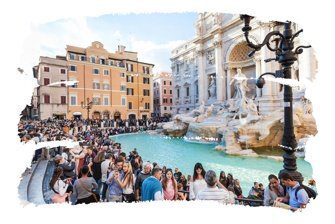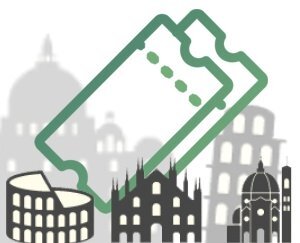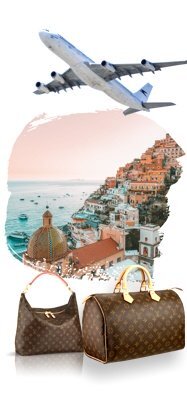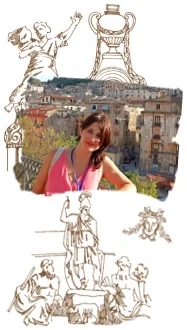Religious tourism in Italy
Italy has always been considered the birthplace of many universally important events and happenings. It is not by chance that numerous trails of believers travel to the country to enjoy the Christian wonders in the national territory and to make pilgrimages in the name of the Lord. Among Christian churches, the Catholic is an institution that has the largest number of believers worldwide. Many representatives and Christian personalities have left their mark of faithful in Italy, thus increasing this feeling of “belonging to a common belief”, which guides and accompanies men to live in society, driven by feelings of love, brotherhood and charity. But after all, let’s learn about religious tourism in Italy? Here at Your Travel to Italy with Ana Patricia you make the trip of your dreams!!! ALSO: see our “Accommodation in Italy – Tips for your holidays!”
Introduction
Every Italian city has a saint or an important person. It would be impossible to talk about all cities, so in this post I will dedicate my attention to some areas that are very important in the world, which are: Rome and the Vatican, Padua, Cassia (and Roccaporena), Assisi, San Giovanni Rotondo and Lanciano.
1) Religious tourism in Italy: VISIT VATICAN AND ROME
In Italy, there is, in fact, the Vatican State, the smallest independent state in the world, led by the Pope, who is the highest recognized religious authority of the Catholic religion. Vatican City is an enclave in the territory of the Italian Republic, and is part of the urban context of Rome. Learn more about ROME!
Pantheon
Rome, however, has always been the scene of many civilizations, each one with its own cult and worshiping its own deities. In fact, in the religious history of Rome, the presence of paganism cannot be ignored. A symbol of devotion to all gods is the Pantheon, still a place of worship today, having become the Church of Saint Mary and Martyrs and sanctuary of the kings of Italy. Near the Pantheon is the Roman Forum, which summarizes some of the city’s most interesting temples: such as the Temple of Saturn, the Temple of Castor and Pollux and the Temple of Vesta.
St. John in Lateran
After this brief dive into the Italian religious past, it is certain to highlight some of the hundreds of churches that Rome has: Saint John in Lateran is the cathedral of Rome and, therefore, is called “Mother of all the churches in the world.”
Basilica of Saint Clement
Nearby, along the way of Saint John in Lateran, is the Basilica of Saint Clement, whose advanced Baroque exterior hides artistic treasures that go back, above all, to medieval times. Passing the Colosseum, you arrive at Esquilino Square, before which you can see the Basilica of Saint Peter in Chains.
Santa Maria Maggiore (“Saint Mary Major”)
Just a few steps and you arrive in front of Santa Maria Maggiore, the best preserved patriarchal basilica. Despite the excellent work as an exterior of the 18th century, the interior is vice versa to offer the greatest artistic inspirations, of which mosaics remain the most recognizable image. Crossing the Tiber River, visit the Basilica of Saint Cecilia in Trastevere, located in the heart of one of the most fascinating neighborhoods in Rome. Of particular interest are works in the priestly area. The true artistic pearl of the basilica is found in the choir of the nuns: this is the Last Judgment painted by Pietro Cavallini.
St. Peter’s Basilica
Finally, following along the Tiber River, towards the north, one arrives at Saint Peter’s Square, Bernini’s masterpiece and antechamber of the most important Catholic architectural ensemble in the world together with the famous Saint Peter’s Basilica. The small Vatican City State welcomes millions of tourists and pilgrims each year, attracted by the beautiful works of art, as well as by the profound symbolic meaning of a place like no other.
Vatican Museums
Inside the Vatican City, one can also admire the Vatican Museums, that is, one of the largest collections of art in the world, since when they exhibit the huge collection of works of art accumulated over the centuries by the Popes. Remember also that the Sistine Chapel and the papal palaces painted by Michelangelo and Rafael are part of the works that visitors to the Vatican Museums can admire on their way. Learn more about Religious Rome!
How to get to Rome?
- By Airplane: Fiumicino Airport is the main Italian airport.
- By train: through Roma Terminal Station (Roma Termini).
- Private Transport: click here with no commitment and get a budgeting.
2) Religious tourism in Italy – VISIT PADUA
Let us now move on to the city of Padua, where Christianity and enormous civic devotion are witnessed by an invaluable religious architectural heritage. There are many sacred places to visit. A religious itinerary, to be worthy of that designation, must absolutely cover, in fact, a visit to Prato della Valle to see the Abbey of Saint Justina (a religious complex consisting of a church and three cloisters). The abbey is one of the oldest testimonies of Christian faith and architecture and is linked to the name of Justina, a Roman aristocratic who was martyred in 304 AD. in this place. Read more about Padua!
St. Anthony’s Basilica
A little distant from this sacred building are the domes of St. Anthony’s Basilica, the goal of millions of faithful each year. The great sanctuary was started in 1232 to store the saint’s remains. Inside you can admire beautiful works of art. See: Padua Hop-on Hop-off Tour: 24-Hour Ticket
Other Churches, Chapels and Oratories
In addition to the great basilicas, in Padua there are many churches, chapels and oratories, often displayed outside the most frequent routes, but rich in history and art. Like the Church of the Hermits with the works by Andrea Mantegna and the Church of Saint Mary of Carmine with a precious cycle of frescoes from the 16th century. Also very fascinating is the small Romanesque Church of Saint Nicholas and the austere Church of Saint Sophia. It is advisable to continue the itinerary between the green of the Euganean Hills, where the visit to the Abbey of Saint Mary of Praglia and its Camaldolese monastery and hermitage, a cloistered place on top of Mount Rua, is very suggestive.
How to get to Padua?
Padua is located in the center of the Veneto region, between the provinces of Vicenza, Treviso, Venice and Rovigo.
By train:
- It is easy to reach by train, since all trains on the Milan – Venice and Bologna – Venice axes stop in Padua: With fast trains you can get here without changes in about 4 hours from Rome or Turin, and just over 2, from Milan or Florence. Even the main places in the northeast can be easily reached from here by train: Venice and Vicenza in about half an hour, Verona and Treviso in an hour, and Cortina in two hours, also with direct connection.
By Airplane:
Padua has a civilian airport, where small planes can land. And yet, you can easily reach the city of Venice’s Marco Polo and Treviso airport through various services:
- car: about 45 minutes / 1 hour, the car rental lists are available on the websites of the airports, it is possible to request a car rental service with driver, provided by several individual companies;
- Taxi: with collective taxi service “Air taxi drivers Cooperativa Pádua” with taxi drivers (www.airservicepadova.it) that allows you to go directly to the final destination. There are also private carrier services. Click here with no commitment and ask for a budgeting;
- Bus: Coach Busitalia – northern Sita.
- Train: It is also very easy to reach from the airport Valerio Catullo (www.aeroportoverona.it), using the direct connections to the train station (www.trenitalia.it)..
Watch this video about La Basilica di Sant´Antonio di Padova
(Source: migantoniowalter)
3) Religious tourism in Italy – VISIT ASSISI
Noteworthy is the city of Assisi, municipality of Umbria. Fully covered by the spirituality of San Francisco, Umbria reveals to tourists places of worship and religious itineraries capable of transforming a vacation into a true mystical experience between medieval villages and the green hills. The tourist, in addition to visiting the famous church dedicated to the saint, can go to the Church of Saint Damian and Saint Clare. On the plain appears the imposing Basilica of Saint Mary of the Angels, built to protect the chapel of Porziuncola (“tiny chapel”).
Basilica of Saint Francis
To visit the first sanctuary, the Basilica of Saint Francis!, consisting of two overlapping churches, it is good to enter the Gate St Peter. From the Basilica, the path of Saint Francis begins, from where you arrive at the City Hall and the New Church, built on the ruins of the saint’s paternal house. One day in Assisi!
Basilica of Saint Clare
Continuing along Corso Mazzini we arrive in front of the Basilica dedicated to Saint Clare. The chapel preserves the crucifix that spoke to the “Povinho”, leading him to conversion and, in the crypt, lies the body of the saint. Moving on, we arrive at the Cathedral of Saint Rufinus, where inside is the fountain from which Saint Francis and Saint Clare were baptized.
Saint Damian’s Convent
Leaving the city, we arrive at Saint Damian’s Convent, where Francis received the divine call to renew the Church, and where Clare spent her life as a cloister. At 4 km rises the Basilica of Sait Mary of the Angels, where inside there is the small church of Porziuncola and not far away, the Chapel of the Transit, where Francis died in 1226. It is worth noting that religious tourism in Assisi offers an unmissable opportunity, aimed at discovering wonderful cultural sites and priceless works of art.
How to get to Assisi?
- Find out here How to get to Assisi from Rome!
- By car: Assisi is easily accessible by car, located not far from major road junctions in central Italy. See our section on Transport in Italy!
- By train: Assisi train station is called Assisi / Santa Maria degli Angeli. Read more about Trains in Italy!
- By plane: For those arriving by plane from more distant locations in Italy or Europe, it may be convenient to arrive by plane. The nearest airport is the Umbro regional airport “San Francesco”, which is located near Perugia, about 12 km from Assisi. The airport is served by some low cost airlines. Another solution may be the “Leonardo da Vinci” International Airport in Fiumicino (Rome), which is about 230 km away.
- Private Transport: click here without obligation and make a budget.
Watch this video about La Basilica di San Francesco di Assisi
(Source: Tv2000it)
4) Religious tourism in Italy – VISIT CASCIA
Another place, as well as a spiritual goal, is Cascia, the city that gave birth to Saint Rita, located in the most mountainous area of Umbria, close to the Parco Nazionale dei Monti Sibillini (Monti Sibillini National Park), known for being one of the main spiritual centers of the region, visited every year for religious tourism. Learn more about the city of Saint Rita of Cascia! The city of Cascia welcomes pilgrims from all over the world. For visits, there is the religious center marked by devotion to Saint Rita, the church of Saint Francis, the Church of Saint Anthony Abbot, the Collegiate Church of Saint Mary and the Church of Santo Augustine.
Of great historical and religious interest appear to be the basilica and monastery of Saint Rita, with the style in imitation of Gothic and Byzantine and the chance to admire the saint’s cell and the rose garden. Palazzi Santi houses the Municipal Museum, which offers interesting archaeological remains and a collection of wooden sculptures among the most important in Italy. Are you staying in Italy? Then discover our section on Accommodation in Italy!
Roccaporena
In the vicinity of Cascia, it is certainly worth visiting Roccaporena and its historic center, where it is possible to find many traces of the life of Saint Rita, which in addition is recommended to visit the Roman temple of Saint Sylvester, which contains ancient ruins of a pagan temple that date back to the 2nd century BC (See my post “How to get to Cascia”). Find out how to get to Cascia from Rome! Private Transport: click here with no commitment and ask for a budgeting.
Watch this video about the Shrine and Monastery of Saint Rita of Cascia
(Source: Bruno Aymone)
5) Religious tourism in Italy – VISIT LANCIAN
Also remember Lanciano, municipality of Abruzzo, recognized as a model of good practices of worship and capital of religious tourism. Learn all about Lanciano! The city is, above all, a cradle of art for the presence of numerous monuments, starting with the sanctuary of the Eucharistic Miracle which preserves the testimony of the oldest Eucharistic miracle in the Catholic world. Lanciano displays an ancient history as evidenced by the excavations carried out in recent years.
Santa Maria Maggiore (“Saint Mary Major”) and Saint Augustine
It is also a city of art, rich in masterpieces of Romanesque and Gothic architecture, including Santa Maria Maggiore and Saint Augustine, with wonderful portals. It has an historic center intact in morphology and typology, with semi-detached houses and neoclassical buildings and the Diocletian Bridge which is original architectural structures, civil and religious, a very complex and unique organism.
How to get to Lanciano?
- By car: from Milan: about 620 km and from Rome: 250 km.
- By train: Pescara Central Station (away from Lanciano, about 35 km), from Pescara by bus.
- By plane: Abruzzo International Airport (Pescara), is about 35 km far from Lanciano. From the airport you can go to Lanciano by taxi or bus to reach Pescara central station and from there take a train or bus.
- By bus: Departing from Rome: Lanciano is connected to Rome (Tiburtina station) with the five daily runs of the Di Fonzo bus lines.
- Private Transport: click here without obligation and make a budget.
Watch this video about The Miracle of Lanciano
(Source: Gaetano Renna)
6) Religious tourism in Italy – VISIT SAN GIOVANNI ROTONDO
Last but not least, to be named among Italian cities, targets of religious pilgrimage, is the city of San Giovanni Rotondo, recognized as an oasis of peace and spirituality. Learn About San Giovanni Rotondo!
Stigmas
San Giovanni Rotondo was the city where Father Pio of Pietrelcina lived for more than 50 years and, and where he died in 1968. Father Pio arrived in San Giovanni Rotondo in 1916. Thus, already in life, many devotees to the monk visited San Giovanni Rotondo, who began to orient himself to receive a large number of believers. The large number of faithful on pilgrimage to San Giovanni Rotondo has also favored the emergence in 2004 of a large sanctuary of Saint Pio. Within the sanctuary today is the crypt with the remains of the saint, placed here in 2010. Anyone who decides to spend their vacation in Puglia, especially in Gargano, cannot escape the tourist flow of thousands of worshipers who incessantly travel to the area from all over the world.
How to get to San Giovanni Rotondo?
- By train: You must get off at Foggia station and from Foggia or with a rental car or take the bus at the station square to San Giovanni Rotondo (SITA company) (tickets can be purchased at the tobacconist in the station yard) .
- By plane: The nearest airport to San Giovanni Rotondo is Foggia’s “Gino Lisa”, which is 40 km away from the city of Gargano.
- Private Transportation: click here with no commitment and get a budgeting.
Watch this video about San Giovanni Rotondo
(Source: Tv2000it)
Conclusion
Religious tourism in Italy? Religion has always been recognized as a guideline for human spirituality, of such importance to many, to replace faith, devotion, hopes, joys and sufferings in it. Progress often takes us far from the true essence of things… times change, habits and technologies evolve, but ideas remain, good always prevails, and worship is transmitted.
These places are, in exception, a testimony of how the religious sense and simplicity remain in our lives and offer an unmissable opportunity to follow a journey that is not only physical, but above all spiritual, in search of themselves and the purest feelings of peace and love.
If you feel insecure, have no time, and need help to organize your trip, don’t hesitate to contact me! I will love to help you make your dream trip to Italy come true. And how can I do that? Keep reading this post until the end and you will understand how we make your life and your trip much easier.
Did my post help you? If so, be sure to post your comment below, but if you still have questions just send me a message I will answer you as soon as possible!
An Extra Help for your Trip
The best content from Your Travel to Italy!
Learn more about our tours in Italy right now!
- What to visit in Italy in 10 days?
- The ten must-see places in Tuscany?
- The best tips to save on your trip to Italy?
- What are the 10 most visited cities in southern Italy?
- Airports in Italy? How to get to your hotel? (Venice, Milan, Rome, Florence)
- What to do in 1/2/3/4 days in the main Italian cities?
- The best tips on food in Italy (wines, typical food, enogastronomy tours)
- How to get from Fiumicino Airport to Rome downtown?
- Your Travel to Italy: 10 tips for traveling through Italy!
Best regards from Italy






 Save money!
Save money!